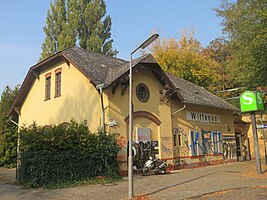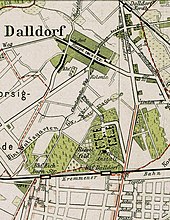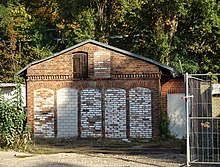Berlin Karl-Bonhoeffer-Nervenklinik train station
| Berlin Karl Bonhoeffer Mental Hospital | |
|---|---|
|
Entrance building of the S-Bahn station
|
|
| Data | |
| Operating point type | Breakpoint |
| Platform tracks | 1 |
| abbreviation | BKBO |
| IBNR | 8089102 |
| Price range | 6th |
| opening |
October 1, 1893 May 28, 1995 |
| Conveyance | January 9, 1984 |
| Website URL | sbahn.berlin |
| Profile on Bahnhof.de | Karl Bonhoeffer Psychiatric Clinic |
| Architectural data | |
| architect | Busse Ernst Schwartz |
| location | |
| City / municipality | Berlin |
| Place / district |
Reinickendorf , Wittenau |
| country | Berlin |
| Country | Germany |
| Coordinates | 52 ° 34 '42 " N , 13 ° 19' 53" E |
| Railway lines | |
|
|
| Railway stations in Berlin | |
The Berlin Karl-Bonhoeffer-Nervenklinik train station is an S-Bahn and an underground station near the former mental hospital in the north of Berlin. The railway station was opened under the name Dalldorf (Kremmener Bahn) in 1893. Later it was called Wittenau (Kremmener Bahn) , although it is not in Wittenau , but in the Reinickendorf district in the district of the same name . In 1984 the company was stopped for several years. When the station reopened in 1995, it was named Karl-Bonhoeffer-Nervenklinik after the name of the underground station on the U8 line that had opened a year earlier . Both station entrances are about 300 meters apart, however, the underground station is already in the Wittenau district. The platform, reception building and utility building of the S-Bahn station are under monument protection.
S-Bahn station
Location and name
The station is located in the north of the Reinickendorf district in the district of the same name on the Kremmener Bahn, which runs approximately in an east-west direction in this area, at km 7.7. The kilometering does not refer to the beginning of the Kremmener Bahn in Berlin-Schönholz station , but the starting point of the Berlin Northern Railway , the former Eberswalder Strasse station , the former Nordbahnhof. The border between the districts of Reinickendorf and Wittenau runs along the railway line; the historic center of Wittenau, which earlier gave the station its name, is about 1.5 kilometers further north.
The area of the former mental hospital begins on the north side of the railway system. About 200 meters east of the station entrance, the train crosses Ollenhauerstraße, the former Berliner Straße, which continues beyond the embankment in Wittenau as Oranienburger Straße. The underground station Karl-Bonhoeffer-Nervenklinik is located under the street north of the embankment.
The station said in his opening Dalldorf Dalldorf (Cremmener train) , which a few months later with the renaming of the city Kremmen to Dalldorf (Kremmener train) was. The addition of brackets in the station name should avoid confusion with the Dalldorf station on the Berlin Northern Railway, which has existed since 1877 . On January 1, 1906, when Dalldorf was renamed Wittenau, the station was named Wittenau (Kremmener Bahn) , and the other Wittenau station was accordingly renamed Wittenau (Nordbahn) . As early as 1994, one year before the station reopened, the name was changed to match the name of the nearby underground station in Karl-Bonhoeffer-Nervenklinik . The operator of the route infrastructure DB Netz runs the station with the addition of Berlin as Berlin Karl Bonhoeffer Nervenklinik .
history
Dalldorf had had a rail connection to the Berlin Northern Railway since 1877. The reason why the place should get another station on the Kremmener Bahn, which was built in the early 1890s, was the insane asylum (later: Karl-Bonhoeffer-Nervenklinik) located near the route. The planning that the station access should be on the side of the track system facing away from the clinic caused irritation. The Royal Railway Directorate in Berlin justified this with the fact that there would only be room for future settlement developed by the railway on the south side. In addition, the siding on the north side, with which the clinic was supplied with coal, stood in the way.
The station was put into operation together with the first section of the Kremmener Bahn from Schönholz to Velten on October 1, 1893. In 1905 the Prussian State Railways had a new, elevated central platform built, and there were now two platform tracks in the station. With the electrification of the suburban railways in the Berlin area, from 1927 the S-Bahn trains also ran on the Kremmener Bahn to Velten via Wittenau (Kremmener Bahn).
At the end of April 1945, the Reichsbahn stopped its S-Bahn operations, and the first trains did not run again until June, albeit with steam. On July 19, 1945, the electric S-Bahn was resumed. The second track of the S-Bahn was dismantled as a reparation payment. Even in the station, which is still only one stopping point, there has only been a single S-Bahn track since then.
After the Wall was built , the S-Bahn no longer ran to Velten or Hennigsdorf, the terminus was Heiligensee . Even after the S-Bahn strike in 1980 , the line was still served by S-Bahns as one of the few in the West Berlin network. It was not until 1984, after the operating rights went to the Berliner Verkehrsbetriebe , that the S-Bahn was stopped.
With the reopening of the S-Bahn from Schönholz to Tegel on May 28, 1995, the station was put back into operation. The station is served every 20 minutes by the S25 line from Teltow Stadt to Hennigsdorf , with only one of the original two tracks in operation.
outlook
Soon after the line was put back into operation in the mid-1990s, there were plans on the one hand for a double-track expansion of the S-Bahn line with a 10-minute cycle to Tegel, and on the other hand for moving the platforms closer to Ollenhauerstraße in order to shorten distances to the U- To reach the train, the buses and the adjacent residential areas. Several dates for the realization of both projects were mentioned, but not met.
To create barrier-free access, it is planned to install an elevator. In 2013 this was announced for the period 2015/2016, but is still not foreseeable as of 2018.
Investments
Reception building
The listed reception building is on site level. It was built in 1902, based on a design by a master builder named Busse. It corresponds to an earlier design for the station building at Schönholz station. It is a single-storey building with a crooked hip roof made of original red, yellow-painted facing masonry and with a carved decorative gable. The design is more rural. A lettering with the old name Wittenau (Kremm. B.) has been preserved on its facade to this day . The building was used as a restaurant until the beginning of the 2010s and has been empty since then.
Platforms
The platform and track systems are high above the ground level. The platform can only be reached from the south side of the tracks. The access structure with the staircase designed by Ernst Schwartz is located in an extension of the reception building at street level. The platform stairs are protected from the weather by a glazed porch.
The platform roof was dismantled after a storm in 2005; The listed cast iron roof supports have been preserved. The design of the roof is unique on the Kremmener Bahn, it corresponds to the type built on a number of stations on the Wannseebahn since 1891.
The track on the south side of the platform has been dismantled since 1945, on the north side there is a platform track used by the S-Bahn trains. Parallel to this is the long-distance track of the Kremmener Bahn, which is still used for occasional journeys to connect a vehicle manufacturer.
Farm buildings
A farm building is also a listed building. This is a small, single-storey coach house west of the reception building. The list of monuments dates it to 1909.
Subway station
Metro Station Karl Bonhoeffer mental hospital is located on the subway line U8 and was only on 29 September 1994 during the Northern Line extension from Metro Station Paracelsus-Bad to the station Wittenau opened. When construction began in 1987, commissioning was originally planned for 1992, but was delayed due to the urgent rebuilding work in the Berlin subway network after German reunification .
Like the other three stations that opened at the same time, the underground station was designed by Rainer G. Rümmler . The walls of the platform hall supported by rectangular pillars and the pillars themselves are clad with light brown and red clinker bricks, the arrangement and color of which are based on the façades of the old clinic buildings (including today's administration building). The ward has several exits from the central mezzanine level, including one almost directly at the entrance to the hospital. There has also been an elevator since the underground station opened.
passenger traffic
The S-Bahn station is served by the S25 line, the underground station by the U8 line. The bus stops at the underground station bus lines X21, M21 and N8 of the Berliner Verkehrsbetriebe .
Web links
- Entry in the Berlin State Monument List with further information (S-Bahn station)
- Karl-Bonhoeffer-Nervenklinik station on kremmener-bahn.net
- Karl-Bonhoeffer-Nervenklinik train station on stadtschnellbahn-berlin.de
- BVG map of the station (PDF; 100 kB)
Individual evidence
- ↑ Station price list 2020. In: Deutsche Bahn. Deutsche Bahn, January 1, 2020, accessed on July 11, 2020 .
- ↑ a b c d e f g h Jürgen Meyer-Kronthaler, Wolfgang Kramer: Berlin's S-Bahnhöfe / A three-quarter century . be.bra verlag, Berlin 1998. ISBN 3-930863-25-1 , pp. 345–346.
- ↑ a b Bahnhof Karl-Bonhoeffer-Nervenklinik at kremmener-bahn.net, accessed on October 11, 2018
- ↑ Further access at S-Bahn stations Alt-Reinickendorf and Karl-Bonhoeffer-Nervenklinik. ( Page no longer available , search in web archives ) Info: The link was automatically marked as defective. Please check the link according to the instructions and then remove this notice. Printed matter No. 0109 / XVIII of BVV Reinickendorf, August 6, 2007.
- ↑ Small question: What are the priorities of the “infrastructure coalition” made up of the SPD and CDU? (PDF; 49 kB) Berlin House of Representatives, April 17, 2012, accessed on May 4, 2012 .
- ↑ Printed matter 17/11585. (PDF; 90 kB) Berlin House of Representatives, March 3, 2013, accessed on April 6, 2013 .
- ↑ a b c Entry in the Berlin State Monument List with further information





